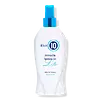What's inside
What's inside
 Key Ingredients
Key Ingredients

No key ingredients
 Benefits
Benefits

 Concerns
Concerns

 Ingredients Side-by-side
Ingredients Side-by-side

Water
Skin ConditioningPropylene Glycol
HumectantCetearyl Alcohol
EmollientCyclopentasiloxane
EmollientBehentrimonium Chloride
PreservativeAlthaea Officinalis Root Extract
Skin ConditioningEuterpe Oleracea Fruit Extract
Anthemis Nobilis Flower Extract
MaskingCamellia Sinensis Leaf Extract
AntimicrobialCamellia Oleifera Leaf Extract
AstringentHydrolyzed Rice Protein
Skin ConditioningHydrolyzed Silk
HumectantHelianthus Annuus Seed Extract
Skin ConditioningQuaternium-80
Panthenol
Skin ConditioningParfum
MaskingMethylparaben
PreservativeGlycerin
HumectantButylene Glycol
HumectantHydroxyisohexyl 3-Cyclohexene Carboxaldehyde
MaskingButylphenyl Methylpropional
PerfumingLinalool
PerfumingCitronellol
PerfumingHexyl Cinnamal
PerfumingLimonene
PerfumingAlpha-Isomethyl Ionone
PerfumingMethylchloroisothiazolinone
PreservativeMethylisothiazolinone
PreservativeWater, Propylene Glycol, Cetearyl Alcohol, Cyclopentasiloxane, Behentrimonium Chloride, Althaea Officinalis Root Extract, Euterpe Oleracea Fruit Extract, Anthemis Nobilis Flower Extract, Camellia Sinensis Leaf Extract, Camellia Oleifera Leaf Extract, Hydrolyzed Rice Protein, Hydrolyzed Silk, Helianthus Annuus Seed Extract, Quaternium-80, Panthenol, Parfum, Methylparaben, Glycerin, Butylene Glycol, Hydroxyisohexyl 3-Cyclohexene Carboxaldehyde, Butylphenyl Methylpropional, Linalool, Citronellol, Hexyl Cinnamal, Limonene, Alpha-Isomethyl Ionone, Methylchloroisothiazolinone, Methylisothiazolinone
 Reviews
Reviews

Ingredients Explained
These ingredients are found in both products.
Ingredients higher up in an ingredient list are typically present in a larger amount.
Parfum is a catch-all term for an ingredient or more that is used to give a scent to products.
Also called "fragrance", this ingredient can be a blend of hundreds of chemicals or plant oils. This means every product with "fragrance" or "parfum" in the ingredients list is a different mixture.
For instance, Habanolide is a proprietary trade name for a specific aroma chemical. When used as a fragrance ingredient in cosmetics, most aroma chemicals fall under the broad labeling category of “FRAGRANCE” or “PARFUM” according to EU and US regulations.
The term 'parfum' or 'fragrance' is not regulated in many countries. In many cases, it is up to the brand to define this term.
For instance, many brands choose to label themselves as "fragrance-free" because they are not using synthetic fragrances. However, their products may still contain ingredients such as essential oils that are considered a fragrance by INCI standards.
One example is Calendula flower extract. Calendula is an essential oil that still imparts a scent or 'fragrance'.
Depending on the blend, the ingredients in the mixture can cause allergies and sensitivities on the skin. Some ingredients that are known EU allergens include linalool and citronellol.
Parfum can also be used to mask or cover an unpleasant scent.
The bottom line is: not all fragrances/parfum/ingredients are created equally. If you are worried about fragrances, we recommend taking a closer look at an ingredient. And of course, we always recommend speaking with a professional.
Learn more about Parfum